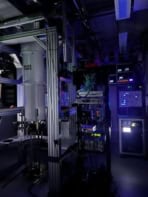
Researchers at the Leibniz Institute for Solid State and Materials Research at IFW Dresden, Germany, have found proof for surface superconductivity in a class of topological materials known as Weyl semimetals. Interestingly, the superconductivity, which comes from electrons confined in so-called Fermi arcs, is slightly different on the top and bottom surfaces of the sample studied. The phenomenon could be used to create Majorana states – long-sought after quasiparticles that could make extremely stable, fault-tolerant quantum bits for next-generation quantum computers. Meanwhile, another group at Penn State University in the US has fabricated a chiral topological superconductor by combining two magnetic materials. Majorana states might also be found in this new material.
Topological insulators are insulating in the bulk but conduct electricity extremely well on their edges via special, topologically protected, electronic states. These topological states are protected from fluctuations in their environment and electrons in them do not backscatter. Since backscattering is the main dissipating process in electronics, this means that these materials might be used to make highly energy-efficient electronic devices in the future.
Weyl semimetals are a recently discovered class of topological material in which electronic excitations behave as massless, Weyl, fermions – first predicted in 1929 by the theoretical physicist Herman Weyl as a solution of the Dirac equation. These fermions behave quite differently to electrons in ordinary metals or semiconductors in that they show the chiral magnetic effect. This occurs when a Weyl metal is placed in a magnetic field, which generates a current of positive and negative Weyl particles that move parallel and antiparallel to the field.
Fermions that can be described by Weyl’s theory can appear as quasiparticles in solids that have linear electron energy bands crossing at so-called (Weyl) “nodes”, the existence of which in the bulk band structure is inevitably accompanied by the formation of “Fermi arcs” on the surface band structure that basically connect pairs of “projections” of Weyl nodes of opposite chirality. Each arc forms half of a loop on the top surface of a sample completed by an arc on the bottom surface.
Electrons confined to Fermi arcs
In the IFW Dresden study, which is detailed in Nature, a team of researchers led by Sergey Borisenko studied the Weyl semimetal platinum–bismuth (PtBi2). This material has some electrons confined to Fermi arcs on its surface. Crucially, the arcs on the top and bottom surfaces of this material are superconducting, meaning that the electrons there pair up and move without resistance. This is the first time that superconductivity has been observed in Fermi arcs, with the bulk remaining metallic, say the researchers, and the effect is possible thanks to the fact that the arcs lie close to the Fermi surface (the boundary between occupied and unoccupied electrons levels) itself.
The team obtained its result using a technique called angle-resolved photoemission spectroscopy (ARPES). This is a complicated experiment in which a laser light source delivers very low-energy photons at very low temperatures and at unusually high emission angles, explains Borisenko. This light is energetic enough to kick out electrons from the sample and a detector measures both the energy and the angle with which electrons exit the material. The electronic structure within the crystal can be reconstructed from this information.
“We have studied PtBi2 before with synchrotron radiation and to be honest we didn’t expect anything unusual,” says Borisenko. “Suddenly, however, we came across a very sharp, bright and highly localised feature in terms of momentum end energy – as it turned out, the narrowest peak ever in the history of photoemission from solids.”
In their measurements, the researchers also observed an opening of a superconducting energy gap within the Fermi arcs. Since only these arcs showed signs of a gap, this means that the superconductivity is entirely confined to the top and bottom surfaces of the sample, forming a sort of superconductor-metal-superconductor sandwich (the bulk of the sample being metallic as mentioned). This structure represents an intrinsic “SNS-Josephson junction”, explains Borisenko.
A tuneable Josephson junction
And that is not all: because the top and bottom surfaces of PtBi2 have distinct Fermi arcs, the two surfaces become superconducting at different transition temperatures, meaning that the material is a tuneable Josephson junction. Such structures show much promise for applications like sensitive magnetometers and superconducting qubits.
In theory, PtBi2 could also be used to create quasiparticles called Majorana zero modes, predicted to come from topological superconductivity. If they are demonstrated in an experiment, they might be used as extremely stable, fault-tolerant qubits for next generation quantum computers, says Borisenko. “Indeed, we are currently investigating the possibility of anisotropy in the superconducting gap in pure PtBi2 and trying to discover similar objects in modified single crystals of the material to find ways of realizing topological superconductivity in it,” he tells Physics World.
Majorana zero modes are not easy to detect however, but in the PtBi2 they could appear when the superconducting gaps open in the Fermi arcs. Much more detailed analyses of the material’s electronic structure will be needed, however, to confirm this, says Borisenko.
Combining two magnetic materials
In a separate study, Penn State University researchers stacked together a ferromagnetic topological insulator and an antiferromagnetic iron chalcogenide (FeTe). They observed robust chiral superconductivity at the interface between the two materials – something that is unexpected since superconductivity and ferromagnetism normally compete with each other, explains study team member Chao-Xing Liu.
“It’s actually quite interesting because we have two magnetic materials that are non-superconducting, but we put them together and the interface between these two compounds produces very robust superconductivity,” says team member Cui-Zu Chang. “Iron chalcogenide is antiferromagnetic, and we anticipate its antiferromagnetic property is weakened around the interface to give rise to the emergent superconductivity, but we need more experiments and theoretical work to verify if this is true and to clarify the superconducting mechanism.”

Weyl loops link up
Again, the system, which is detailed in Science, might be a promising platform for exploring Majorana physics, he says.
Borisenko says that the data from the Penn State researchers is “very interesting” and as in his group’s work, Liu, Chang and colleagues appear to have found evidence of unusual superconductivity, albeit at a different type of interface. “In our work, the surface is an interface between the bulk and the vacuum rather than between two materials,” he says.
The Penn State researchers also aim to prove topological superconductivity but they have added the necessary ingredients – symmetry breaking and topology – in a more artificial way by bringing the relevant materials together to form a heterostructure, he explains. “In our case, due to the unique nature of Weyl semimetals, these ingredients are naturally present in a single material.”



